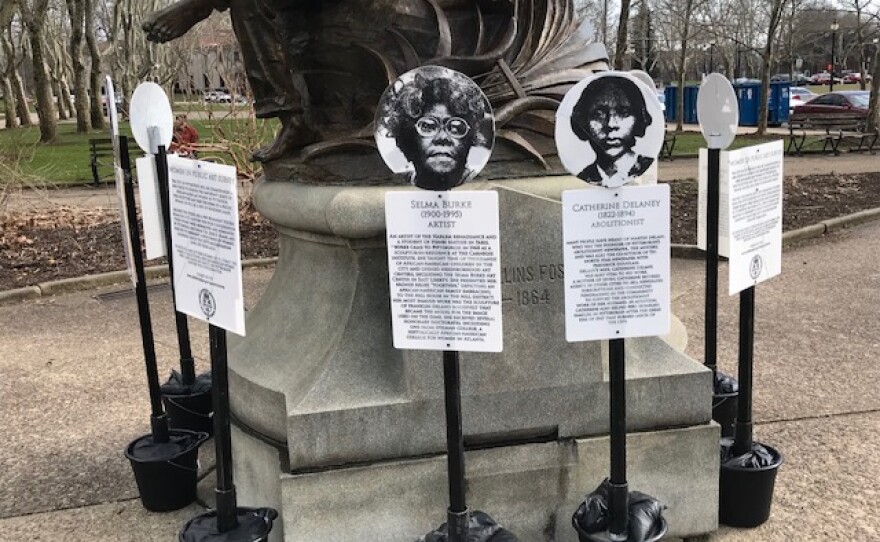The former site of the Stephen Foster statue in Oakland is still generating controversy.
Last year, debate over the bronze monument many criticized as racist was accompanied by a call for public art honoring women of color. No such artwork currently exists in Pittsburgh. Mayor Bill Peduto convened the Task Force on Women in Public Art, and this past spring, the group held a series of five public forums around the city seeking input.
On Wednesday, the task force reported to the Art Commission of Pittsburgh that the public seems to want a statue honoring a woman or women of color on the very site of the Foster monument – a prominent location on Forbes Avenue right by the main branch of the Carnegie Library of Pittsburgh.
But art-commission members objected that simply putting a new statue on the same site was a bad idea, calling it a “knee-jerk reaction” to the Foster statue and a “Band-Aid” for a site that caused grief to many.
Lindsay Powell, assistant chief of staff in the mayor’s office, was among those who delivered the task force findings. She said the five forums considered issues including where a monument to women of color might be placed; whether it should be permanent or temporary; whether it should honor one woman or many; and which historical figures it should honor. Stakeholders included the Women & Girls Foundation, the Hill House Foundation, Manchester Craftsmen’s Guild and the Urban League of Greater Pittsburgh.
As for whom to honor, Powell said forum attendees were given a list of seven African-American women from Pittsburgh history as possible subjects for monuments. But participants were told that other women could be considered.
Most of the votes were registered in an online survey. Of the 1,114 votes counted as of this past Wedneday, Powell said, the top vote-getter was educator and civic leader Jean Hamilton Walls, the first African-American woman to earn a bachelor’s degree from the University of Pittsburgh. (That was in 1910; 28 years later, Walls became the first African-American woman to earn a doctorate at Pitt.) Walls garnered 301 votes. Pioneering Pittsburgh police officer and activist Gwen Elliot received 183 votes, and artist Selma Burke received 179. The survey is ongoing.
However, Powell told the commission that forum participants also expressed a desire for more than just one monument to women of color. “This is hopefully the first of many,” said Powell.
She added that contributors were “thinking intentionally about how we use art to convey what our city celebrates, but by no means is this supposed to be a kind of one-for-one replacement” of a new honoree for Foster.
Art commissioners, however, did seem to view the potential use of the former Foster site as risking just that perception. The 120-year-old bronze monument depicted the famed Pittsburgh-born composer with a shoeless African-American man at his knee, playing a banjo. It was removed in April.
“I actually don’t think that something should go in that actual place,” said Kilolo Luckett, an art historian. When she heard about the task force, she said, “I felt that it might be a little knee-jerk reaction to something that was very divisive in Pittsburgh. … [W]hy this location? Why not look at the City of Pittsburgh as a whole …?”
Several commissioners voiced similar concerns. “I believe we are being very clear that we think it would be a mistake to do the project you’re proposing for the site,” acting chair Andrew Moss told the task force.
Powell reiterated that the project was not a direct response to the Foster statue. Moss, an architect, countered that it would be seen that way.
Jessie Ramey, a Chatham University professor and task-force member whose Oct. 15 op-ed in the Pittsburgh Post-Gazette sparked creation of the task force and who did the initial research on the seven potential honorees, told the commission that whatever monument is built, it would not be the end of the story. In the public forums, she said, “We talked about the opportunity to perhaps build many pieces, not a one-and-done process.”
But some commission members voiced concern that doing the project on the Foster site might be perceived as ending the debate over women of color in public art.
“There’s a lot of grief over that still – why that statue existed. There’s a lot of debate to be had there,” said Sarika Goulatia, an artist. "I think that before a statue goes up, there needs to be a time when there’s healing and discourse in that space."
Goulatia added the site could become a place for performance-art "instead of just placing a statue of a black woman."
But Esther Bush, a task-force member who is president and CEO of the Urban League of Greater Pittsburgh, said a statue on the former site of the Foster monument would go a long way toward addressing those issues.
“When I first got a telephone call about the possibility of a statue to a black woman, I said, ‘I will keep my schedule to make as many meetings as I can,” Bush said. And one big motivator she said, was the Foster statue itself, and the legacy of racism it represented.
“Putting [a new statue] in the same place of the previous statue can be healing for many,” she said. “It is symbolic if a black female were to be placed where it was. … It will allow all of our citizens in Pittsburgh and visitors to have some of those tough conversations that are still so difficult between the races in Pittsburgh in the United States of America.”
The art commission has final say over public artworks in Pittsburgh. But the task force’s presentation last week was a “courtesy review” and no vote was taken. Further public discussion of the issue is expected.






